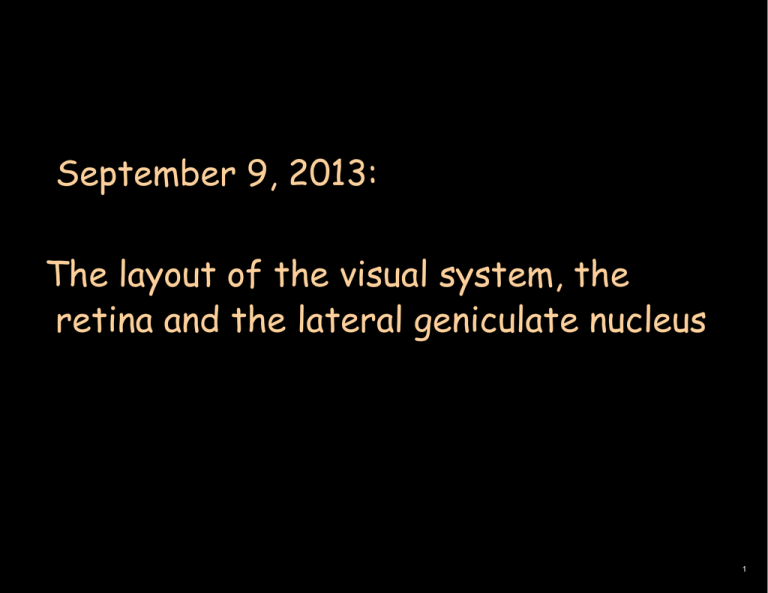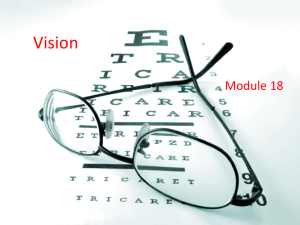
September 9, 2013:
The layout of the visual system, the
retina and the lateral geniculate nucleus
1
Basic Wiring of the Visual System
2
The world seen by the two eyes
Seen by both eyes
Seen by both eyes
Seen by left eye
Seen by right eye
Seen by left eye
Seen by right eye
Image by MIT OpenCourseWare.
rabbit
human
3
Primates Image removed due to copyright restrictions.
Please refer to lecture video or Figure 3 from Schiller, Peter H., and Edward J. Tehovnik.
"Visual prosthesis." Perception 37, no. 10 (2008): 1529.
5
Basics of Retinal Connections
and Retinal Ganglion Cells 6
Cornea
Posterior chamber
Limbal zone
Iris
Chamber
lia
ry
bo
dy
Anterior
far
Conjunctiva
Canal of Schlemm
Ciliary muscle
Ci
Lens
Zonule
fibers
Ciliary
process
Rectus
tendon
Ciliary epithelium
Ora serrata
Retrolental space
Optic axis
Visual axis
near
Canal of
Cloquet
Vitreous humor
Retina
Sclera
Choroid
Disc
Fovea
Lamina cribrosa
Ner
ve &
shea
th
Macula
lutea
Horizontal section of the right human eye.
Image by MIT OpenCourseWare.
7
Fovea
Optic nerve
Human Retina
Foveal cone density: 200,000/sqmm
Foveal cone density: 200,000/sqmm
5 degrees out: 20,000/sqmm
5 degrees out: 20,000/sqmm
10 degrees out: 10,000/sqmm
10 degrees out: 10,000/sqmm
Image by MIT OpenCourseWare.
8
Image removed due to copyright restrictions.
Please refer to lecture video or to Polyak, Stephen Lucian. The Vertebrate Visual System:
Its Origin, Structure, and Function and its Manifestations in Disease with an Analysis of its
Role in the Life of Animal and in the Origin of Man. Edited by Heinrich Kluver. University
of Chicago Press, 1957.
9
Retinal ganglion cells, cross section, Golgi label
Image removed due to copyright restrictions.
Please refer to lecture video or Figure 4 from Schiller, Peter H. "Parallel information processing
channels created in the retina." 3URFHHGLQJVRIWKH1DWLRQDO$FDGHP\RI6FLHQFHV 107, no. 40
(2010): 17087-17094.
by Polyak
10
Physiology of retinal ganglion cells
11
Whole mount cat retina, Nissl stain
Image removed due to copyright restrictions.
Please see lecture video or Figure 1 from Wassle, H., W. R. Levick, and B. G. Cleland.
"The distribution of the alpha type of ganglion cells in the cat's retina." Journal of Comparative
Neurology 159, no. 3 (1975): 419-437.
14
Conduction velocity in optic nerve fibers
Rapid
Slower
Very slow
Three populations of fibers
Image by MIT OpenCourseWare.
15
Image removed due to copyright restrictions.
Please see lecture video or Figures 2 and 3 from Watanabe, M. and R.W. Rodieck. "Parasol and midget
ganglion cells of the primate retina." Journal of Comparative Neurology 289, no. 3 (1989): 434-454.
16
Photoreceptors
18
Image removed due to copyright restrictions.
Please refer to lecture video or Figure 1 from Schiller, Peter H., and Edward J. Tehovnik.
"Visual prosthesis." Perception 37, no. 10 (2008): 1529.
19
Rods and cones in periphery
Image removed due to copyright restrictions.
Please see lecture video or Figure 1 from Winkler, Kenneth C., and Pasko Rakic.
"Distribution of photoreceptor subtypes in the retina of diurnal and noctournal primates."
The Journal of Neuroscience 10, no. 10 (1990): 3390-3401.
In human retina there are about 120 million rods and about 5 million cones
20
Distribution of rods and cones on the retina
1.2
2000
1.0
1600
0.8
1200
0.6
800
0.4
400
0.2
0
80
60
40
20
0
20
Fovea
Degrees from the fovea
Relative visual acuity
Rods (number)
Cones (number)
Relative visual
acuity in degrees
from the fovea
Blind spot
Number of rods or cones in an area 0.0069 sq mm
2400
0
40
60
80
Distribution of rods and cones along a horizontal meridian. Parallel vertical lines represent the blind
spot. Visual acuity for a high luminance as a function of retinal location is included for comparison.
Image by MIT OpenCourseWare.
21
Some basic facts about the receptor array:
1 degree = 200u on retina
Intercone distance in fovea = 2.4u (0.7 min)
200,000 cones per sq.mm. in fovea
20,000 cones per sq.mm. 5 degrees out Thumbnail at arm's length = 1 degree
The 12 font letter "I" activates about 80 cones at 23 cm
Each rod has 1,000 disks, each with 10,000 molecules
Only 1 of 8 cones is blue. Red and green are equal.
23
Bipolar cells
25
Cat bipolar cells
Kolb, Helga, Ralph Nelson, and Andrew Mariani. "Amacrine cells, bipolar cells and ganglion cells of the cat retina: a Golgi study."
Vision Research 21, no. 7 (1981): 1081-1114. Courtesy of Elsevier, Inc., http://www.sciencedirect.com. Used with permission.
Horizontal cells
27
Image removed due to copyright restrictions.
Please refer to lecture video or to Polyak, Stephen Lucian. TKH9HUWHEUDWH9LVXDO6\VWHP
,WV2ULJLQ6WUXFWXUHDQG)XQFWLRQDQGLWV0DQLIHVWDWLRQVLQ'LVHDVHZLWKDQ$QDO\VLVRILWV
5ROHLQWKH/LIHRI$QLPDODQGLQWKH2ULJLQRI0DQEdited by Heinrich Kluver. University
of Chicago Press, 1957.
28
A Horizontal cell with regularly arranged dendrites that
is connected to 15 cones in a cone density region of 20.
Image by MIT OpenCourseWare.
29
Amacrine cells
30
Labeled and injected cholinergic amacrine cell
Images removed due to copyright restrictions.
Please see lecture video or Figure 2 of Masland, Richard H.
"The functional architecture of the retina." 6FLHQWLILF
$PHULFDQ255, no. 6 (1986): 102-11.
31
Cholinergic
cholinergic cell
All
All cell
Dopaminergic
dopaminergic cell
Image by MIT OpenCourseWare.
32
Electrical responses in the retina
33
DC recording
Receptors
all hyperpolarize to light
Horizontal Cells
all hyperpolarize to light
Bipolar Cells
mudpuppy
retina
some hyperpolarize and some depolarize
Amacrine Cell
some hyperpolarize, some depolarize
and some give action potentials
(Necturus maculosus)
oscilloscope
Ganglion Cells
all give action potentials
0
-50
epsp
© American Physiological Association. All rights reserved. This content is excluded from our Creative Commons license. For more information, see
http://ocw.mit.edu/help/faq-fair-use/. Source: Figure 2 and 3 from Werblin, Frank S., and John E. Dowling. "Organization of the Retina of the Mudpuppy.
Necturus macubsus. II. Intracellular Recording." J. Neurophysiol 32 (1969): 339.. 5 (2009): 1231-1246.
Photoreceptor basics:
1. All photoreceptors hyperpolarize to light.
2. Depolarization of the photoreceptor releases glutamate.
3. Photon absorption by the photopigment results in isomerization
of the chromophore from 11-cis to all-trans. This causes
hyperpolarization thereby reducing neurotransmitter release.
4. Two classes of bipolars are the ON and the OFF. The synaptic
junction of OFF bipolars is sign conserving; that of the ON
bipolar is sign inverting.
5. The ON bipolar receptor is mGluR6. Its activation leads to
closing of channels causing hyperpolarization.
36
MIT OpenCourseWare
http://ocw.mit.edu
9.04 Sensory Systems
Fall 2013
For information about citing these materials or our Terms of Use, visit: http://ocw.mit.edu/terms.









